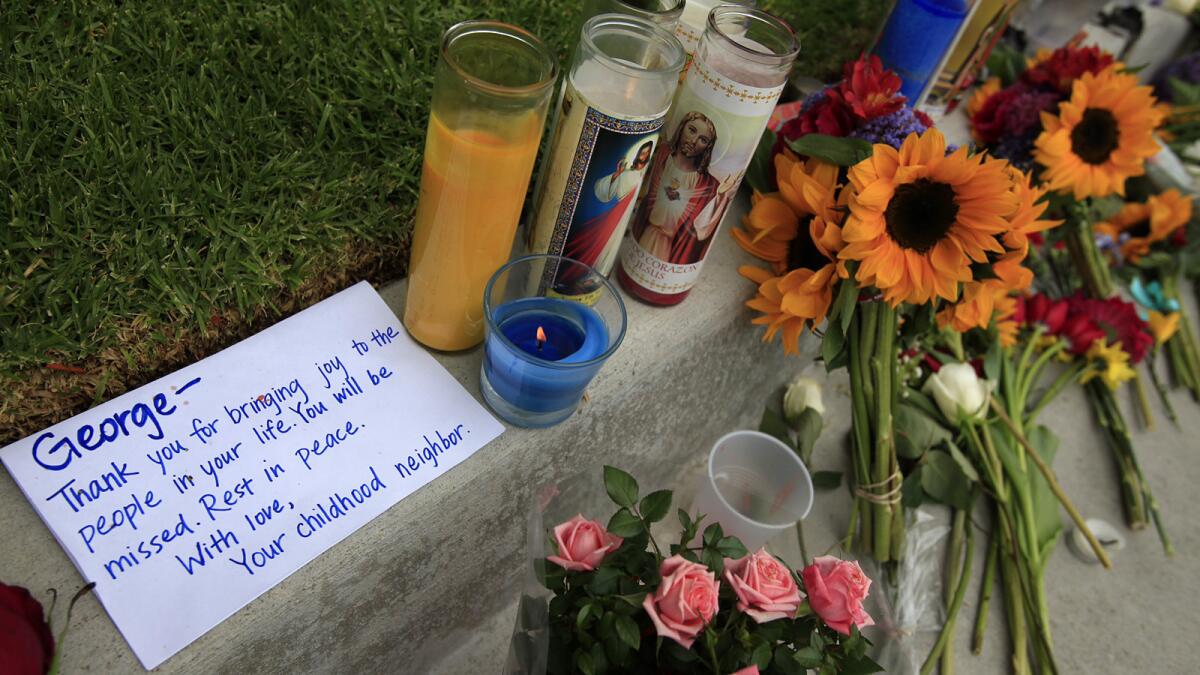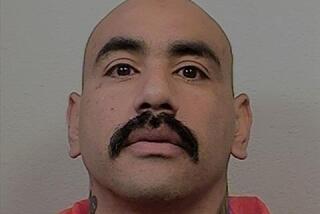In Isla Vista, red flags came too late

Reporting from Isla Vista, Calif. — Elliot Rodger enjoyed sunsets, mountain vistas, retro pop music. He said it time and again: The world was a magical, beautiful place, but only in stark contrast to his small, pitiful life. “No friends,” he said one day this spring, in a video recorded on his phone. “No love.”
It’s tempting, now that the finale has been written, to think that someone could have stepped in before Rodger killed six people and wounded 13 Friday before apparently killing himself, that the law could have been crafted to raise a red flag, to compel someone to act.
But according to interviews with Rodger’s acquaintances, law enforcement officials and mental health professionals, all that was known about the 22-year-old college student was that he was terribly sad. And being sad is not a crime, nor the sort of mental state that would, alone, cross a legal threshold requiring official response.
The mental health system is imperfect, by design — a teeter-totter that weighs patients’ civil liberties against public safety. Rodger existed in the middle, on the fulcrum, simmering and disturbed, just beyond arm’s reach.
In that quiet space he planned his attack — lonely, but highly functioning; worrisome, but never explicitly threatening himself or anyone else; bumping into police, but never landing in jail; resistant to medication, but never outright rejecting care; able to articulate his misery, but conniving enough that authorities did not see a need for involuntary hospitalization.
The writing may have been on the wall, but no one — despite the apparently diligent efforts of his family, therapists and doctors, and law enforcement — knew what it said until it was too late.
“We never, as a society, got that opportunity with this boy — to find out if society could have intervened,” said Carla Jacobs, a prominent advocate for an effective mental health system in California.
The son of a Hollywood director, Rodger grew up privileged in Calabasas and Woodland Hills. He had traveled extensively, to Morocco, Singapore and England. All along, he harbored a crushing darkness. His family suspected he was somewhere on the autism spectrum, and he had been in therapy since childhood. He was prescribed psychotropic drugs but declined to take them, he wrote.
Belying the aggressive personality seen on his now-notorious videos, he spoke haltingly and did not look people in the eye, said Simon Astaire, a family friend. “He was fundamentally withdrawn,” Astaire said.
“He was very standoffish,” said Thom McFadden, who lived next door to Rodger’s father, Peter, in Woodland Hills. “A loner.”
Dr. George Woods, a San Francisco psychiatrist who lectures on mental health and the law, said Rodger appeared to have been in an early phase of pre-psychosis. The ability to mask symptoms is common, he said.
“Oftentimes you’ll see that the paranoia is in the service of the delusion,” Woods said. “They aren’t telling people their business.”
The family was caring and attentive, said family friend Adam Krentzman. Peter Rodger “is the sweetest, nicest, most genuine, caring person, and he did everything he could,” Krentzman said.
But after Elliot turned 18, he started rejecting mental health care that his family provided, Krentzman said. “He turned his back on all of it,” he said. “At some point, your kid becomes an adult.”
Elliot Rodger became increasingly isolated, sometimes by his own design. He complained that he couldn’t make friends, but acquaintances said in interviews that he rebuffed their attempts to be friendly.
Bitterness rising, Rodger began to resent the carefree students in the tight-knit Isla Vista community, where more than half of the 23,000 residents are students at the nearby UC Santa Barbara. He viewed himself as a sophisticate and a catch, and reserved much of his venom for attractive women, who he believed spurned him, and men who had more success in dating.
One night last summer, he went to a party and tried to shove women off a ledge where they had been sitting. Several men intervened and pushed him off the ledge instead, and he injured his ankle.
He was treated at a clinic for his injuries, and police showed up to interview him. In theory, this was an opening for formal, official intervention. But the officers determined that Rodger was “not a victim,” a Santa Barbara County sheriff’s spokeswoman said Sunday — that he had instigated the altercation.
Asked if there was anything about that incident that would have prompted authorities to follow up with Rodger, spokeswoman Kelly Hoover replied: “No.”
Around the same time, Rodger hatched his plan for what he called “slaughter” and began buying semiautomatic handguns. Again, here was an opportunity for official scrutiny — he was making the purchases legally, abiding by California’s background check system and waiting periods.
But Rodger sailed through, because despite his troubles, it does not appear that he triggered any warnings — he had no criminal history; he had never explicitly threatened anyone or been deemed a risk to himself or others; he had never been ordered to submit to involuntary mental health treatment; he had no history of addiction.
Even a diagnosis of serious mental illness, in itself, would not have prevented Rodger from buying a gun under California law, said Lindsay Nichols, staff attorney with the advocacy group Law Center to Prevent Gun Violence.
If Rodger had issued a threat of violence against specific, identifiable victims to a psychiatrist, the psychiatrist would have been required to report it to law enforcement, and Rodger could have been banned from owning guns for five years. That did not happen, and there is no evidence that Rodger made such a threat — in fact, his writings suggest that he had worked studiously to hide his violent plan.
Adam Winkler, a UCLA law professor and expert on gun laws, said that in general, a diagnosis of mental illness doesn’t affect a person’s right to own a gun in California unless it has been adjudicated by a court or the person has voluntarily checked into a mental facility.
“It’s just not a surprise that someone with mental health problems would still be able to get a gun,” Winkler said.
Chuck Michel, one of the most prominent gun-rights attorneys in California, said there was nothing in Rodger’s background that would have prevented him from being able to buy a gun.
“California’s got pretty much every gun control law the gun control lobby wants, and it didn’t stop this,” he said.
More recently, Rodger began to post numerous videos to YouTube. Some were innocuous. Most, though, were brooding and dark.
At one point, he filmed from his glistening BMW as two young people kissed on a park bench in the distance. “I hate the world because no girl would do this with me,” he said.
Rodger’s parents were disturbed by the videos, family friends said. Mental health professionals put them in touch with the Sheriff’s Department, and in April, deputies visited Rodger at his apartment, the same one where he would soon stab and kill three men to launch his rampage.
Rodger would later write that he was terrified when deputies knocked on his door — terrified that they would find his weapons, his ammunition and the detailed written plans of his attack. He feared he would be “denied of the chance to exact revenge on my enemies.”
Rodger wrote that he “tactfully” told the officers there had been a misunderstanding — that everything was fine. They believed him.
Hoover, the Santa Barbara County spokeswoman, said the April visit by sheriff’s deputies is now under investigation, and she declined to discuss the details. But, she said: “Generally speaking, unless we have a lawful reason to enter a residence, we cannot do so without a warrant. An exception would be if deputies felt that a person was a harm to themselves or others or there was an immediate threat. In this case, we would have had to determine that Elliot Rodger or his roommates were in immediate danger.”
That did not happen, said Sheriff Bill Brown. Rodger had “a very convincing story,” he said.
Officers could have more aggressively investigated Rodger and his mental state. For instance, officers could have checked records to see if he legally owned weapons. “But if they’re just saying someone is not functioning well and exhibiting signs of depression, I can’t see that they’d have a reason to do that,” Woods, the San Francisco psychiatrist, said.
Had officers found Rodger a danger to himself or others, they could have placed him on an involuntary psychiatric hold, known as a “5150.” But the laws governing such aggressive action “are stringent,” Woods said.
“And I think they’re appropriately made that way. There has to be an acute reason, when you’re talking a danger to yourself, a danger to others, or gravely disabled. There was no way that in these kinds of interviews and with his presentation that you could have made the conclusions.”
Earlier this month, Orange County became the first large county in California to implement Laura’s Law, allowing court-ordered treatment for the severely mentally ill. The law allows family members, licensed mental health providers, police officers and others to refer potential patients for treatment.
That law is not on the books in Santa Barbara County — but even if it were, proponents of the law conceded that Rodger would almost certainly not have qualified, given what was known about him at the time.
So the deputies left, and never came back. “The biggest wave of relief swept over me,” Rodger wrote.
He decided to launch his attack on Friday because if he’d waited past the weekend, the semester would have begun to wind down at the nearby university, and many of his “enemies” would be leaving for the summer.
At 9:17 that night, 13 minutes before the first gunshots rang out, his mother, Chin Rodger, was at home in a western suburb of Los Angeles when her phone rang. It was one of her son’s therapists. “Have you gotten Elliot’s email?” he asked.
Chin Rodger opened the email, according to an account of the night provided to The Times by a family friend. Something had changed. Her dejected son was gone, replaced by a man with a savage view of the world, and a terrible plan.
“This is the story of how I, Elliot Rodger, came to be,” the email said. “It is a dark story of sadness, anger and hatred.” Then: “I will punish everyone. And it will be beautiful. Finally, at long last, I can show the world my true worth.”
Chin Rodgers frantically called her ex-husband, Peter, who was out to dinner. Together, they raced up the 101 Freeway. But it was too late. The radio started barking while they were still on the road — a vicious rampage in Isla Vista, a young man emptying his guns into crowds of pedestrians. By the time they reached the police station there, it was over.
On Sunday evening, a crowd prayed in front of the Alpha Phi sorority house in Isla Vista, where Rodger shot three women, two of whom died. There was a surprising amount of compassion for Rodger — for how he lived, if not how he died.
“The insecurities and rejection he felt is something I believe exists in a lot of hearts in this city,” said Yvette Johnson, 22. “There’s this unspoken survival of the fittest.... If you don’t fit in a box, you’re going to feel rejected.”
“Some people think that he doesn’t deserve love,” said Christina Perez, 24. “But we all deserve love.”
Contributing to this report were Times staff writers Adolfo Flores and Kate Mather in Isla Vista, and Amy Kaufman, Joe Mozingo, Bob Pool, Garrett Therolf and Richard Winton in Los Angeles.
More to Read
Sign up for Essential California
The most important California stories and recommendations in your inbox every morning.
You may occasionally receive promotional content from the Los Angeles Times.











